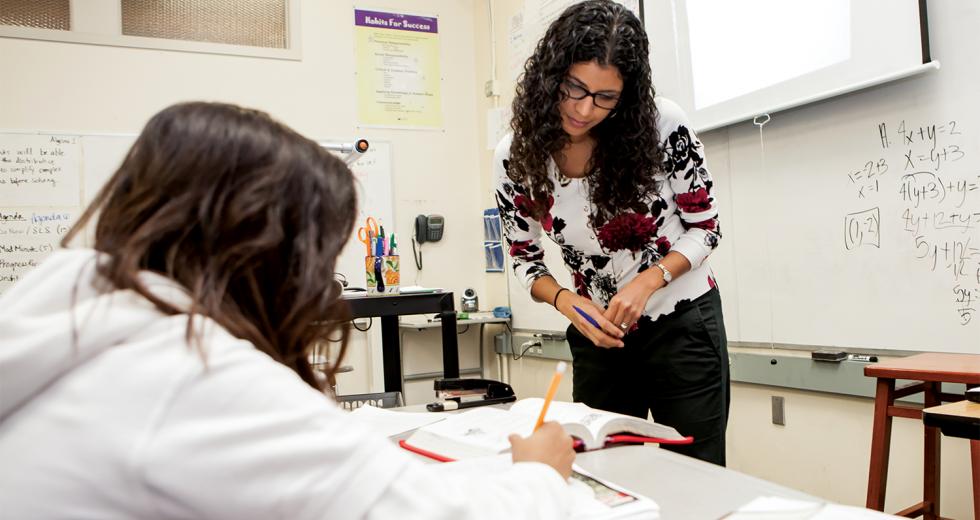Much of the discussion about how to improve education has been reduced in recent years by a venomous national debate over whether teachers should be judged by the standardized test scores of their students.
Regardless of who’s right, the failure of school administrators and teacher unions to agree on a system that incorporates bubble-test results into teacher performance evaluations continues to bar California school districts from millions in federal education grants.
But as educators across the state remain stuck in an ideological stalemate, other districts and charter schools have embraced innovative evaluation systems that hold teachers accountable for student performance. In San Jose Unified School District, administrators and the local teachers union recently signed off on a new evaluation method that would combine student academic growth reports and interviews with a wide swath of people affected by teachers: students, parents, colleagues and supervisors.
“We realized the current evaluation process doesn’t affect anybody,” says Stephen McMahon, president of the San Jose Teachers Association. “We spent a lot of time talking to our teachers about when a student enters your classroom on day one; there should be improvement when they leave. We need to find a way to capture that and measure it.”
Though not yet implemented, San Jose’s negotiated system includes provisions that break some new ground for a California school district. There are financial incentives for teachers who raise their students’ academic achievement and a means to ferret out consistently poor-performing teachers by allowing a panel of school faculty to dismiss them. Alternately, the school district agreed to not incorporate standardized test scores, which, despite their controversy for relying on memorization skills instead of critical thinking, are strongly promoted by the Obama administration and other school reform advocates.
McMahon says the deal came together because both the union and administrators washed their hands of past distrust and pushed themselves toward full transparency.
“You got to walk in putting your guard down a little bit, and commit to doing what you think is in the best interest of your school district. Both sides need to do that,” McMahon says. “Our discussions are healthy because (there is no) hidden agenda. The agenda is really trying to do what is best, and I think more unions need to approach the work that way.”
McMahon says his local union is supported by the California Teachers Association and the National Education Association.
In most California schools, including those in the Capital Region, teacher evaluation policies are bargained at the local level, and the provisions differ from school district to district. But in general, supervisors rarely visit teachers to monitor and review their classroom pedagogy. Newer teachers are supposed to undergo this review process more often, though budget cuts have stifled that practice across the state.
Salary raises for teachers are dictated by years of experience and the number of graduate classes taken, not performance. And because of due process, administrators encounter extreme difficulty in dismissing tenured teachers perceived to be ineffective. While ongoing statewide education budget cuts have made it easier to reduce the teaching workforce, those same reductions have created California classrooms packed with 40 kids. That is one of the many learning challenges teachers say make a student-performance-based evaluation unfair. Other academic barriers include student hunger, poverty and family violence.
“It’s been bumpy and hard and produces a ton of anxiety for all of us. But it has inarguably made us better.”
Heather Kirkpatrick, educator
But despite these uncontrollable economic factors that influence learning, the teaching profession deserves a data-driven evaluation system, school reformers argue. In recent years, many non-unionized charter schools have taken the lead on crafting a uniform evaluation method. Aspire Public Schools, a statewide charter chain, has devised an evaluation metric that uses 29 indicators to pinpoint teachers’ strengths and weaknesses. The indicators include a teacher’s ability to engage students in learning and use the Internet as a research tool.
Aspire uses an online platform called Purple Planet that
organizes the results. Teachers are placed into several tiers of
effectiveness based on their composite scores, and they can
access recommendations on how to improve or contribute resources
for their peers who may be struggling with the same material. Top
performers are rewarded with year-end bonuses and promotions.
“For teachers with more experience and who have gone without constructive criticism for a long time, I think this new process is uncomfortable. … But nobody expects you to be perfect. I feel like it’s helped me develop as a teacher, and that’s worthwhile,” says Sarah Salazar, an algebra teacher at an Aspire school in Berkeley.
But overhauling an entrenched process doesn’t come without growing pains. The new system is time consuming, and some teachers have complained that it’s subjective and unfair, says Heather Kirkpatrick, another Aspire teacher in Berkeley.
“It’s been bumpy and hard and produces a ton of anxiety for all of us. But it has inarguably made us better,” Kirkpatrick says. “Having our 34 principals and all the people who surround them have a nuanced and shared understanding of effective teaching is very powerful. It’s changed our conversations.”
In Los Angeles, the nation’s second-largest school district is seeking volunteers for a performance-based evaluation pilot that relies in part on standardized test scores. The local teachers union has yet to sign off on the model, though the district contends the focus is on improving all teachers, not rooting out and firing bad ones.
“The question is: Is the evaluation system for sorting or supporting teachers? And we’ve been on the side of supporting,” says Drew Furedi, executive director for talent management at Los Angeles Unified School District.
Last year, approximately 425 teachers and 100 administrators participated in the district’s voluntary pilot and were placed into four tiers of effectiveness, says Furedi. The lion’s share of the evaluation result is tied to classroom observations, and the final scores had no direct impact on yearly compensation. Rather, the highest-scoring teachers will be considered first for promotions.
However, the United Teachers of Los Angeles union has not signed off on the new system, and administrators fear the lack of endorsement could cause the district to miss out on the latest series of competitive grants offered by the federal government.
Despite strides being made in a few areas in California, the prospect of a statewide evaluation system faces steep challenges. In September, proposed state legislation that would have tied student test scores to evaluations won the support of the California Teachers Association but ultimately failed because of opposition from other education interest groups.
Los Angeles Unified argued the bill would have undermined the system it already is putting in place. Some interest groups also opposed the bill’s requirement that evaluation processes be collectively bargained in each district — an element that was crucial in gaining the CTA’s support. Policymakers are crafting a new proposal for the next legislative session.
Earlier this year, Green Dot, a charter school with a unionized teacher workforce, signed a contract to incorporate a multi-measure tool similar to those at Aspire and other charters. The model does not include merit pay for student performance because administrators say money doesn’t ultimately motivate a teacher as much as job satisfaction.
“We’re pretty excited about the work,” says Cristina de Jesus, chief academic officer at Green Dot. “I think reforming the evaluation system is absolutely crucial. Teachers want help, and they want to be the best they can be.”
— Additional reporting by Allen Young
For more information about Jayson Carpenter: www.jaysoncarpenter.com
Recommended For You

Renewable Resources
Los Rios prepares to roll out updated student support services
Thomas Hanns was homeless when he first enrolled in classes at Sacramento City College, one of four main campuses that make up the Los Rios Community College District.

Teach it Forward
How one woman paid her education forward
Asha Canady’s parents didn’t go to college. Her brothers didn’t make it out of high school. But it was expected, from a young age, that Canady and her twin sister would succeed in higher education.



